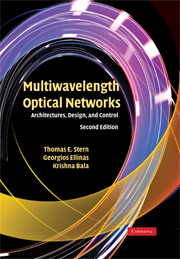Book contents
- Frontmatter
- Contents
- Figures
- Tables
- Preface to the Second Edition
- Acknowledgments
- Multiwavelength Optical Networks
- 1 The Big Picture
- 2 The Layered Architecture and Its Resources
- 3 Network Connections
- 4 Enabling Technology
- 5 Static Multipoint Networks
- 6 Wavelength/Waveband-Routed Networks
- 7 Logically-Routed Networks
- 8 Survivability: Protection and Restoration
- 9 Optical Control Plane
- 10 Optical Packet-Switched Networks
- 11 Current Trends in Multiwavelength Optical Networking
- A Graph Theory
- B Fixed Scheduling Algorithm
- C Markov Chains and Queues
- D A Limiting-Cut Heuristic
- E An Algorithm for Minimum-Interference Routing in Linear Lightwave Networks
- F Synopsis of the SONET Standard
- G A Looping Algorithm
- Acronyms
- Index
E - An Algorithm for Minimum-Interference Routing in Linear Lightwave Networks
Published online by Cambridge University Press: 05 June 2012
- Frontmatter
- Contents
- Figures
- Tables
- Preface to the Second Edition
- Acknowledgments
- Multiwavelength Optical Networks
- 1 The Big Picture
- 2 The Layered Architecture and Its Resources
- 3 Network Connections
- 4 Enabling Technology
- 5 Static Multipoint Networks
- 6 Wavelength/Waveband-Routed Networks
- 7 Logically-Routed Networks
- 8 Survivability: Protection and Restoration
- 9 Optical Control Plane
- 10 Optical Packet-Switched Networks
- 11 Current Trends in Multiwavelength Optical Networking
- A Graph Theory
- B Fixed Scheduling Algorithm
- C Markov Chains and Queues
- D A Limiting-Cut Heuristic
- E An Algorithm for Minimum-Interference Routing in Linear Lightwave Networks
- F Synopsis of the SONET Standard
- G A Looping Algorithm
- Acronyms
- Index
Summary
Given a source s and destination d for a point-to-point connection on a selected waveband in an LLN, the Min-Int algorithm presented here attempts to find a minimum-interference optical path p = 〈s, d〉 for that connection on the given waveband. The exact sense in which interference is minimized requires some explanation and is defined in Section E.3.
The Image Network
The approach used to find a path that minimizes interference is based on shortest path calculations, where the path “length” takes into account weights or “lengths” representing currently active interfering signals. These weights are associated with nodes rather than links. A useful way of visualizing the node-weighting procedure is shown in the image network of Figure E.1. In the network shown in the figure, each node of the original network is “blown up” to create additional intranodal links between each input/output port pair. This is nothing more than a representation of the internal structure of the LDC on the chosen waveband (see Figure 2.19[b]). The image network of Figure E.1 corresponds to the state of activity in the network of Figure 6.55. Two optical connections, (1, 1*) and (2, 2*), are active, with signal S1 transmitted from station 1 to 1* and signal S2 transmitted from station 2 to 2*.
We shall denote an internodal link from node i to node j by (i, j) and assign it a positive weight d(i, j).
- Type
- Chapter
- Information
- Multiwavelength Optical NetworksArchitectures, Design, and Control, pp. 893 - 895Publisher: Cambridge University PressPrint publication year: 2008

